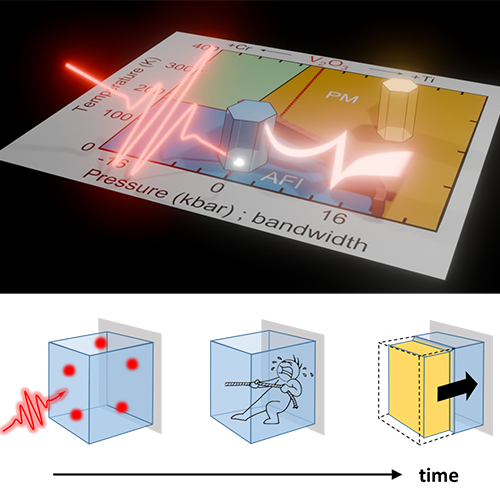High-speed travel of a light-induced insulator-metal transition
https://english.univ-nantes.fr/medias/photo/image2_1730717881781-png
-
Le 18 octobre 2024false false
Researchers from the Nantes Jean Rouxel Institute of Materials (IMN), the Institute of Physics of Rennes (CNRS - University of Rennes) and the University of Tohoku (Sendai - Japan), brought together within the CNRS-Japan International Research Laboratory DYNACOM, have shown that the photoinduced metal-insulator transition in quantum materials - called Mott insulators - propagates at the speed of sound thanks to a deformation wave compressing the material. This work, published in Nature Physics, makes it possible to envisage Mottronic components reacting in a few picoseconds.
The spectacular advances in ultrafast lasers, rewarded by the Nobel Prize in Physics in 2018 and 2023, have opened up new avenues for studying materials, offering the possibility of manipulating their electronic properties towards new states that were previously inaccessible. Applying an ultrashort laser pulse to quantum materials - called Mott insulators - thus causes a phase transition towards a transient metallic state. For a long time, this transition was thought of as a transition of electronic origin for which the coupling to the lattice (i.e. to the structure of the material) played a secondary role.
But in their work published in the journal Nature Physics , researchers from the international DYNACOM laboratory have just shown that it is on the contrary the coupling to the lattice that drives the propagation of the insulator-metal transition. By combining time-resolved measurements probing both electronic and structural changes, they have indeed shown that the electronic photoexcitation caused by the laser pulse induces internal pressure constraints which then trigger, from the free surface, the propagation at the speed of sound of a volumetric deformation wave in the thickness of the material. The insulator-metal electronic transformation thus follows the wave of this deformation wave which compresses the material. These results were obtained thanks to key time-resolved X-ray diffraction experiments at the ESRF in Grenoble, France and at MAX IV in Lund, Sweden.
Beyond the fundamental aspects, this work shows that ultimate switching times of the order of picoseconds are possible in devices resulting from Mottronics, a new electronics using the properties of Mott insulators studied in particular by IMN researchers. This opens the way to the creation of new memories and artificial neural networks up to a thousand times faster than existing technologies.

Top: Artist's view of the phase diagram of the Mott material V2O3, highlighting its initial insulating state (blue) before its photoexcitation by an ultrafast laser which pushes it towards a metallic state (yellow) by a strain wave propagation mechanism.
Bottom: Schematic representation of the transformation mechanism operating at the speed of sound. From left to right: initial photo-excitation (a) inducing a negative internal pressure (b), followed by propagation of the electronic transformation in the wake of a compressive strain wave front (c).
But in their work published in the journal Nature Physics , researchers from the international DYNACOM laboratory have just shown that it is on the contrary the coupling to the lattice that drives the propagation of the insulator-metal transition. By combining time-resolved measurements probing both electronic and structural changes, they have indeed shown that the electronic photoexcitation caused by the laser pulse induces internal pressure constraints which then trigger, from the free surface, the propagation at the speed of sound of a volumetric deformation wave in the thickness of the material. The insulator-metal electronic transformation thus follows the wave of this deformation wave which compresses the material. These results were obtained thanks to key time-resolved X-ray diffraction experiments at the ESRF in Grenoble, France and at MAX IV in Lund, Sweden.
Beyond the fundamental aspects, this work shows that ultimate switching times of the order of picoseconds are possible in devices resulting from Mottronics, a new electronics using the properties of Mott insulators studied in particular by IMN researchers. This opens the way to the creation of new memories and artificial neural networks up to a thousand times faster than existing technologies.

Top: Artist's view of the phase diagram of the Mott material V2O3, highlighting its initial insulating state (blue) before its photoexcitation by an ultrafast laser which pushes it towards a metallic state (yellow) by a strain wave propagation mechanism.
Bottom: Schematic representation of the transformation mechanism operating at the speed of sound. From left to right: initial photo-excitation (a) inducing a negative internal pressure (b), followed by propagation of the electronic transformation in the wake of a compressive strain wave front (c).
Mis à jour le 04 novembre 2024.
